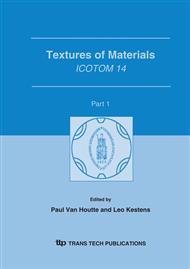p.1013
p.1019
p.1025
p.1031
p.1037
p.1043
p.1049
p.1055
p.1061
The Role of Texture, Temperature and Strain Rate in the Activity of Deformation Twinning
Abstract:
Plastic deformation in cubic metals is relatively simple due to the high crystallographic symmetry of the underlying structure. Typically, one unique slip mode can provide arbitrary deformation. This is not true in lower symmetry hexagonal metals, where prismatic and basal slip (the usual favored modes) are insufficient to provide arbitrary deformation. Often, either pyramidal slip and/or deformation twinning must be activated to accommodate imposed plastic deformation. The varied difficulty of activating each of these deformation mechanisms results in a highly anisotropic yield surface and subsequent mechanical properties. Further, the relative activity of each deformation mode may be manipulated through control of the initial crystallographic texture, opening new opportunities for the optimization of mechanical properties for a given application.
Info:
Periodical:
Pages:
1037-1042
Citation:
Online since:
September 2005
Keywords:
Price:
Сopyright:
© 2005 Trans Tech Publications Ltd. All Rights Reserved
Share:
Citation:


